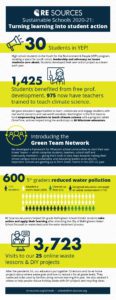By Priscilla Brotherton, Sustainable Schools Program Manager
“I should have added water to every step since nothing is done without water!”
This was a “light bulb moment” of a 5th grade teacher after completing an exercise that traced the resources used to bring a meal to a table and what is wasted when that food isn’t consumed.
 Although the 2020-2021 school year was far from ideal for many, light bulb moments did happen. This simple exercise when facilitated with students brought unexpected topics into the conversation. It turns out this was no simple science lesson. Students asked questions about the farm and factory workers. They wondered how to reduce the cost of curbside compost for those least able to afford it. They questioned the impact of different foods on climate change. They asked tough questions.
Although the 2020-2021 school year was far from ideal for many, light bulb moments did happen. This simple exercise when facilitated with students brought unexpected topics into the conversation. It turns out this was no simple science lesson. Students asked questions about the farm and factory workers. They wondered how to reduce the cost of curbside compost for those least able to afford it. They questioned the impact of different foods on climate change. They asked tough questions.
And they wanted answers.
And these were elementary school students.
The Sustainable Schools program has, like everyone, had a school year like no other. The summer of 2020 had us questioning the way we taught, what we taught and how we taught it. With systemic racism front and center during a pandemic, a simple “pivot” wouldn’t be enough. So we doubled down on all the programming that we felt truly makes a difference to our youth. We wanted to equip students with the ability to not only seek the answers to the questions they were asking but do it in a way that offers hope and truth. Together, we:
- Amplified student voices through our Youth for the Environment and People (YEP!) Program by doubling the cohort of high school students and offered a stipend to ensure equitable access.
- Offered students a way to take action and do something about pollution through county-wide litter clean-ups and stormwater pollution prevention projects.
- Designed the Green Team Network, a new program launching this fall, to ensure all students across Whatcom County can improve sustainability at their schools.
- Helped teachers to meet their students’ needs by offering workshops and lesson plans on topics such as: how to bring solutions and actions to the classroom, climate science and how to teach outside.
- Collaborated with other organizations to ensure students were offered a wide range of services instead of similar programs that compete.
- Offered all programming for free to ensure that all in our community can participate.
Check out this infographic with some of this year’s impacts by the numbers
But we still wonder, is this enough? Next school year will be here before we know it. There will be new challenges to face and questions to answer. But if we listen to what the youngest members of our community are demanding and offer them a seat at the table, together we can create a better education system and, in turn, a better future for us all. We will be there to meet the challenges and watch the light bulb moments!
